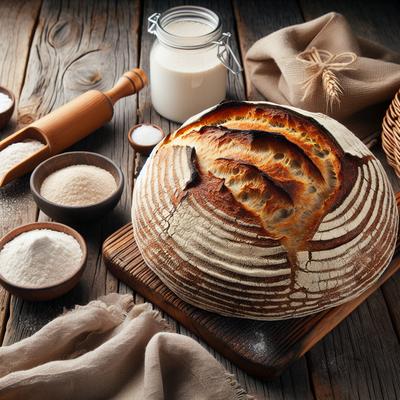Rustic Country Sourdough Bread
Discover the art of baking with this Rustic Country Sourdough Bread recipe, a timeless classic that brings the warmth of an artisan bakery right into your home. Made with just four simple ingredients—active sourdough starter, bread flour, warm water, and fine sea salt—this recipe is a testament to the beauty of slow fermentation and natural leavening. With its irresistibly crisp golden crust and soft, tangy crumb, this bread is perfect for hearty sandwiches, dipping into soups, or enjoying simply with butter. Featuring methods like the autolyse technique and stretch-and-folds for optimal gluten development, this recipe is ideal for both seasoned bakers and enthusiastic beginners looking to master sourdough. Whether proofed overnight for deeper flavor or baked fresh, this loaf will fill your kitchen with the comforting aroma of rustic goodness.
Try SnapCalorie's FREE AI assisted nutrition tracking free in the App store or on Android.

Scan with your phone to download!

Ingredients
- 150 grams Active sourdough starter
- 350 grams Warm water
- 500 grams Bread flour
- 10 grams Fine sea salt
Directions
Step 1
In a large mixing bowl, combine 150 grams of active sourdough starter with 350 grams of warm water. Mix until the starter is fully dissolved.
Step 2
Add 500 grams of bread flour to the mixture and stir until no dry flour remains. The dough will be shaggy at this stage. Cover the bowl with a damp cloth and let it rest for 30 minutes.
Step 3
After the resting period (autolyse), sprinkle 10 grams of fine sea salt over the dough. Use your hands to mix the salt into the dough until it is fully incorporated.
Step 4
Begin a series of stretch and folds to develop gluten structure: with damp hands, grab one side of the dough, stretch it upward, and fold it over the top. Rotate the bowl 90 degrees and repeat. Perform this step 3–4 times in a single session. Cover the dough and let it rest for 30 minutes.
Step 5
Repeat the stretch-and-fold process every 30 minutes for a total of 4 sessions. After the last session, cover the bowl and let the dough bulk ferment at room temperature for 4–6 hours, or until it has doubled in size and looks airy.
Step 6
Turn the dough out onto a lightly floured surface. Gently shape it into a round or oval loaf, being careful not to deflate it. Place the shaped dough seam-side up into a floured proofing basket or bowl lined with a floured kitchen towel.
Step 7
Cover the dough and let it proof at room temperature for 1–2 hours, or until it passes the 'poke test' (a lightly pressed finger indent springs back slowly). Alternatively, refrigerate it overnight for a slow proof and enhanced flavor.
Step 8
When ready to bake, preheat your oven to 250°C (480°F) with a Dutch oven or cast-iron pot inside for at least 30 minutes.
Step 9
Carefully transfer the dough from the basket to a piece of parchment paper. Score the top of the dough with a sharp knife or razor blade to allow for expansion.
Step 10
Using oven mitts, remove the preheated Dutch oven from the oven. Transfer the scored dough (along with the parchment paper) into the hot Dutch oven and cover with the lid. Bake for 20 minutes.
Step 11
After 20 minutes, remove the lid to allow the crust to brown. Reduce the oven temperature to 230°C (450°F) and bake for an additional 20 minutes, or until the crust is deeply golden and the loaf sounds hollow when tapped on the bottom.
Step 12
Carefully remove the bread from the Dutch oven and let it cool completely on a wire rack before slicing and serving.
Nutrition Facts
| Serving size | (1010g) |
|---|
| Amount per serving | % Daily Value* |
|---|---|
| Calories | 1895 |
| Total Fat 8.2g | 0% |
| Saturated Fat 1.6g | 0% |
| Cholesterol 0mg | 0% |
| Sodium 3891.5mg | 0% |
| Total Carbohydrate 395g | 0% |
| Dietary Fiber 15.0g | 0% |
| Total Sugars 1.5g | |
| Protein 61.5g | 0% |
| Vitamin D 0IU | 0% |
| Calcium 82.5mg | 0% |
| Iron 22.8mg | 0% |
| Potassium 530mg | 0% |
Source of Calories
